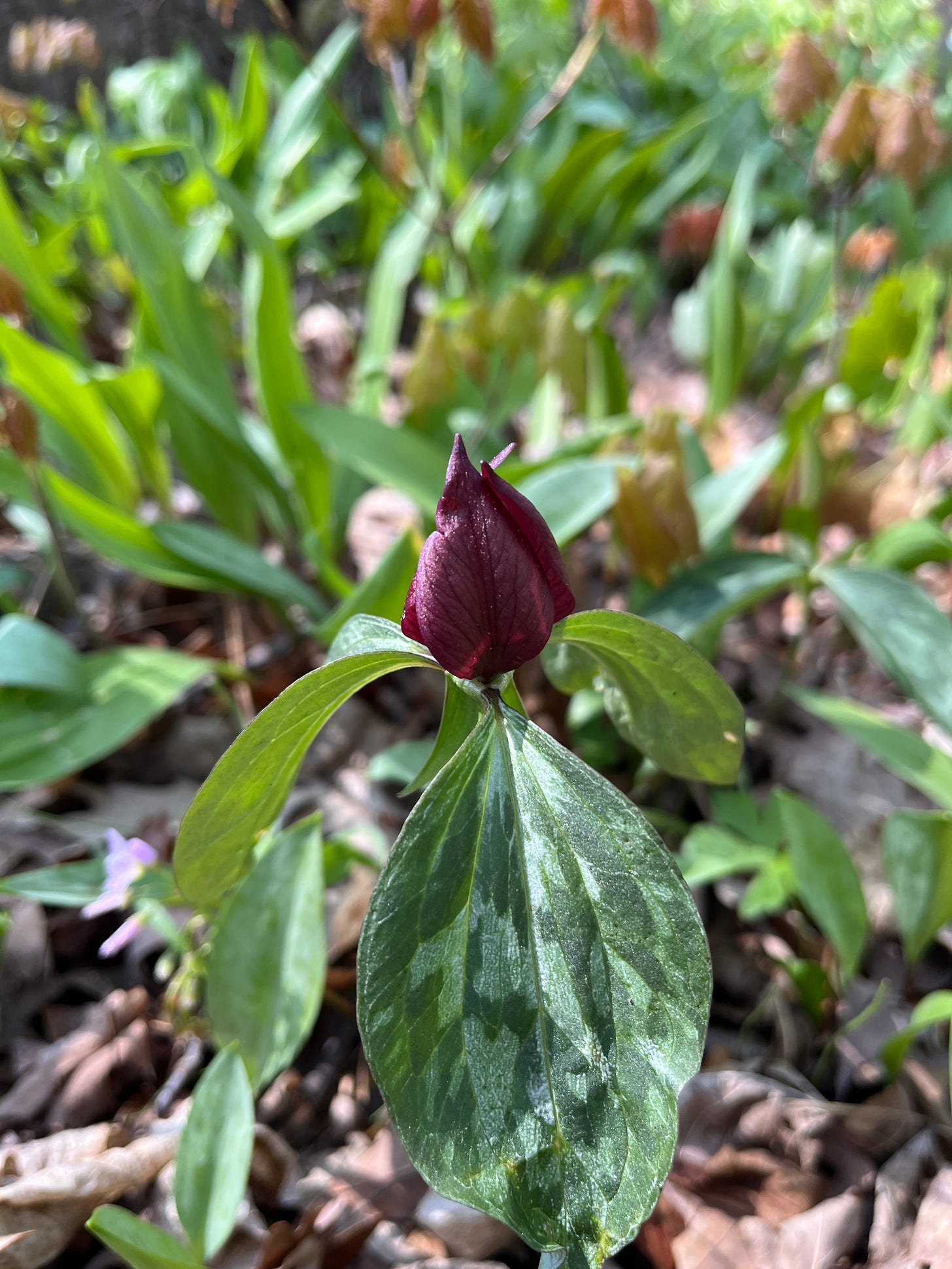What is a Wake-Robin?
"Silently the procession passes" and we will be awaiting the Wake-Robin yet again.
Upon first hearing the term “Wake-Robin,” one might imagine a particularly alert American Robin. Or at least the ones that sing all hours of the night through much of spring.
There’s a place along Lake Erie, Wake-Robin Marsh, separated by a headland from the big lake itself. It’s not a very well-known place to birders, but on the right spring morning it can be competitive with other notable spots on the lake, like the famous Magee Marsh of northwest Ohio. The short trail there can be lined with warblers when the winds are out of the south.
But, alas, a Wake-Robin is not a bird at all. John Burroughs was a 19th-century writer and naturalist who wrote for Atlantic Monthly and was a friend of Walt Whitman. His 1863 essay, Wake-Robin, was the first chapter of his book by the same name. So, here is a look at a Wake-Robin:
The Wake-Robin is a perennial wildflower that most people know of as the trillium. The above photo shows a Large-flowered Trillium in a Midwestern woodland.
Burroughs’ essay is about springtime and the return of the birds to northern latitudes.
It is this period that marks the return of the birds,—one or two of the more hardy or half-domesticated species, like the song sparrow and the bluebird, usually arriving in March, while the rarer and more brilliant wood-birds bring up the procession in June. But each stage of the advancing season gives prominence to the certain species, as to certain flowers. The dandelion tells me when to look for the swallow, the dogtooth violet when to expect the wood-thrush, and when I have found the wake-robin in bloom I know the season is fairly inaugurated. With me this flower is associated, not merely with the awakening of Robin, for he has been awake for some weeks, but with the universal awakening and rehabilitation of nature.
Here’s where he mentions the connection to the robin—the bird species, which sort of “awakens” when it comes back north. Spring has officially begun when the robins have returned1 and the Wake-Robins are in bloom. The above trillium only blooms for a short time, when the trees are still mostly bare and frost is still a possibility. A few other species like the White Trout Lily and Wild Leek carpet the floor along with the trillium.

Burroughs did go on to praise the American Robin, though he notes the bird’s shortcomings when it comes to nest building, described as “coarse material and rough masonry.” I am not sure what Burroughs meant above by “half-domesticated species, like the song sparrow and the bluebird.” It might be a way of saying these birds were fairly comfortable around human habitation, or at least that they spent all year in urban or semi-urban environs. Here’s some more on the robin, which had me thinking about the time a curious number of robins arrived in my backyard two years ago.
Robin is one of the most native and democratic of our birds; He is one of the family, and seems much nearer to us than those rare, exotic visitants, as the orchard starling or rose-breasted grosbeak, with their distant, high-bred ways. Hardy, noisy, frolicsome, neighborly, and domestic in his habits, strong of wing and bold in spirit, he is the pioneer of the thrush family, and well worthy of the finer artists whose coming he heralds and in a measure prepares us for.
Burroughs had a lengthy writing career and was quite renowned during his time, rubbing shoulders with a who’s who2 of early 20th century American life. Strangely enough, Burroughs died just about 40 miles from what became Wake-Robin Marsh. He was riding on a train through northeast Ohio, on his way back to his home state of New York in 1921.
His writing resonates at this time of year, even as we have had unseasonably warm weather.
But summer wanes, and autumn approaches. The songsters of the seed-time are silent at the reaping of the harvest….The birds, in a new but less holiday suit, turn their faces southward. The swallows flock and go; the bobolinks flock and go; silently and unobserved, the thrushes go. Autumn arrives, bringing finches, warblers, sparrows, and kinglets from the north. Silently the procession passes. Yonder hawk, sailing peacefully away till he is lost in the horizon, is a symbol of the closing season and the departing birds.
Silently the procession passes, and in a few months we will be pining for so many birds to come back north.
I learned about Burroughs from Angelia Kumlien Main’s 1925 work, Bird Companions. Click here to read my post about that book, “A Different Kind of Bird Guide.”
Recall that many, many robins spend the winter in northern climes, despite Burroughs’ descriptions.
One photograph from 1914 shows Burroughs with Henry Ford and Thomas Edison. This would be like David Sibley hanging out with Elon Musk and Bill Gates.




Bob. Thank you for spotlighting John Burroughs’ work from so long ago. He had a profound impact educating people at a time when nature writing was animals in smoking jackets promoting the status quo of the elite. Trillium blooms are such an awakening of spring along with lady slippers, and trout lilies, mayflowers and wood anemones.
Thanks, I didn't know about Burroughs. His writing is reminiscent of Thoreau. Here in the Northeast we have the Painted Trillium and the Red Trillium; just gorgeous to see a carpet of these if one happens to be out in the woods at the right time.